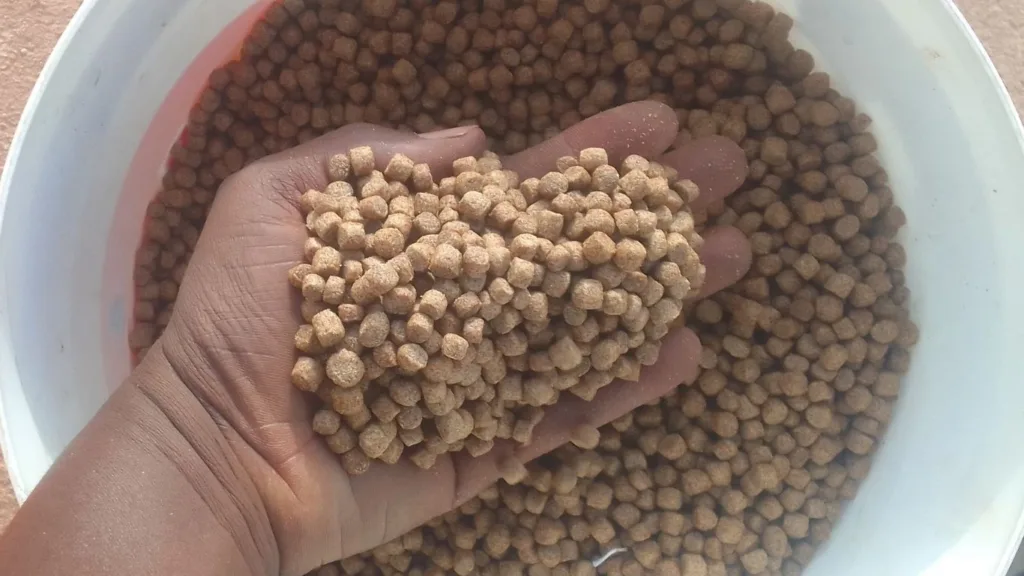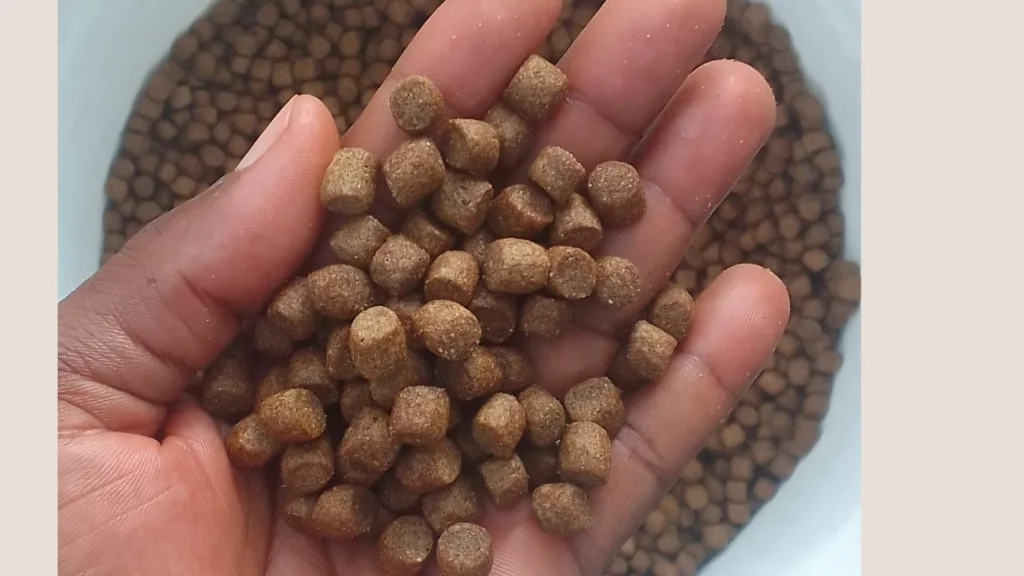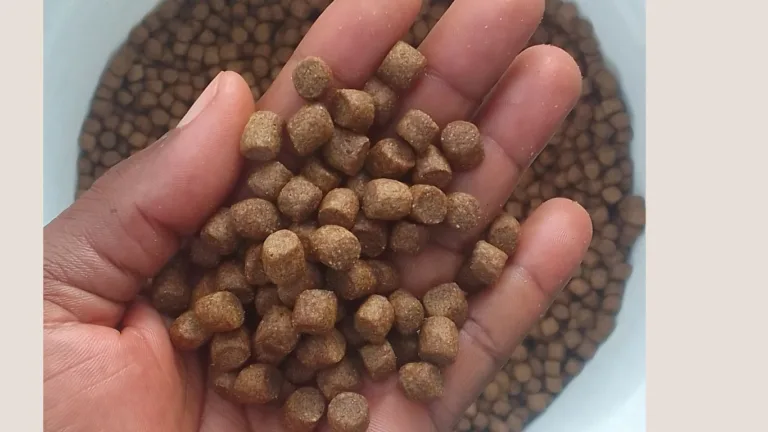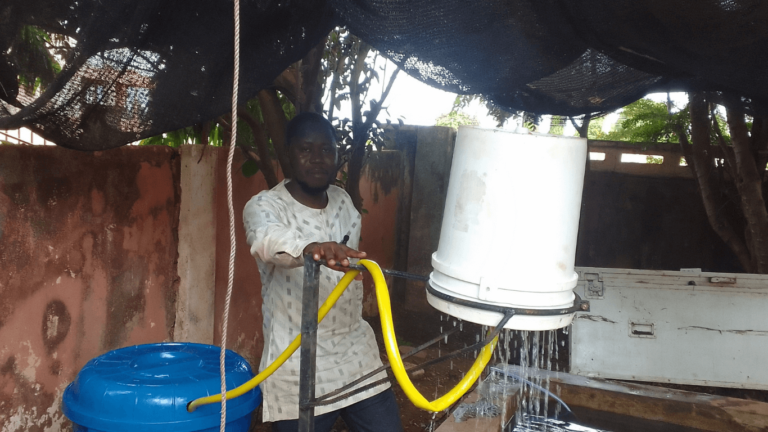How to choose the right feed size for your fish at each growth stage is crucial for their healthy development. Many fish farmers struggle with this, often leading to poor growth or malnutrition. Understanding the correct feed size for each growth phase ensures that your fish receive the right amount of nutrients they need to thrive. We’ll break down the importance of feed size and guide you through the appropriate feed for each category of fish. From fingerlings to jumbo fish.
Whether you’re a beginner or an experienced fish farmer, mastering feed sizes will help you achieve optimum growth, higher profits, and a healthier fish stock.
Understanding Fish Growth Stages and Feed Size
Each fish has specific nutritional needs at different stages of growth. Fish are generally categorized into different sizes as they grow: fingerlings, post-fingerlings, juveniles, post-juveniles, and jumbo.
At each of these stages, the feed size needs to match the size of the fish. That way, they can consume it effectively and absorb the necessary nutrients. Let’s dive into each category and explore how to choose the right feed size for your fish at any given stage.
Fingerling Stage
The fingerling stage is the initial phase of fish growth and requires special attention. These fish seeds are fragile and still developing essential organs and functions. The fingerling stage itself is divided into three categories based on the size and weight of the fish.
Fingerlings Weighing 0.5 to 0.8 Grams (3-4 cm in Length)
At this size, fingerlings are still very small and delicate. The recommended feed size for fish at this stage is 0.5 mm to 0.8 mm. This small feed size ensures that the young fish can consume the food easily and receive adequate nutrition for growth.
Fingerlings Weighing 0.9 to 1.2 Grams (4-5 cm in Length)
As your fingerlings grow slightly bigger, they will need slightly larger feed. Fish in this weight category should be given 0.8 mm to 1.2 mm feed. This ensures that the fish can consume the pellets without struggling, leading to faster growth and better health.
Fingerlings Weighing 1.3 to 1.4 Grams (5-6 cm in Length)
At this stage, the fish are starting to gain more weight and length. The right feed size is 1.2 mm to 1.5 mm, allowing them to continue growing while still receiving the proper nutrients in digestible amounts.
Post-Fingerling Stage
The post-fingerling stage comes after the initial fingerling phase, and the fish are now stronger and bigger. Proper feeding at this stage sets the tone for healthy growth through the juvenile stage.
Post-Fingerlings Weighing 1.5 to 2.1 Grams (6-7 cm in Length)
For fish at this stage, the recommended feed size is 1.2 mm to 1.5 mm. This size allows the fish to consume their food more effectively without straining their developing digestive systems. If you don’t learn how to choose the right feed size for your fish, you will choose the wrong one.
Post-Fingerlings Weighing 2.2 to 3.8 Grams (7-8 cm in Length)
The next weight category within the post-fingerling stage requires a slightly larger feed size, typically 1.5 mm to 1.8 mm. This ensures that the growing fish get sufficient nutrients, contributing to their overall health and vitality.
Juvenile Stage
As your fish enter the juvenile stage, their dietary needs become even more critical. Ensuring the right feed size at this point can significantly impact their rate of growth and final harvest size.
Juveniles Weighing 3.9 to 7 Grams (8-10 cm in Length)
Juveniles are larger and more developed than fingerlings, and they require feed sizes of 1.5 mm to 1.8 mm. This provides a good balance between digestibility and nutrient intake, ensuring steady growth.
Juveniles Weighing 7.1 to 9 Grams (10-10.5 cm in Length)
For fish in this size range, a feed size of 1.8 mm to 2 mm is optimal. This allows the fish to continue growing while taking in the essential nutrients they need for their developing organs and bones.
Post-Juvenile Stage
As fish grow beyond the juvenile stage, they enter the post-juvenile stage. This is crucial for preparing them for adulthood and harvest.
Post-Juveniles Weighing 9.1 to 13 Grams (10.5-12 cm in Length)
At this stage, fish require a larger feed size of 2 mm. This ensures they can ingest sufficient quantities of nutrients as they prepare to enter the jumbo stage.
Jumbo Stage
The jumbo stage is the final phase before harvest, where fish are expected to have achieved significant growth. Proper feeding in this phase is critical to maximizing your yield and profitability.
Jumbo Fish Weighing 13.1 to 17 Grams (12-14 cm in Length)
The appropriate feed size for fish at this size is 2 mm. This feed size is large enough to accommodate their growing size and nutrient demands as they approach maturity.
Jumbo Fish Weighing 17.1 to 23 Grams (14-17 cm in Length)
For jumbo fish in this weight range, it is ideal to provide them with a 3 mm feed size. This allows the fish to ingest more nutrients in each feeding. Also ensuring they receive the proper nutrition to support their larger body size. At this stage, fish are nearing their full growth potential, and feeding them the proper pellet size will help ensure they grow to their maximum capacity before harvest.
Jumbo Fish Weighing 23.1 to 35 Grams (17-20 cm in Length)
Fish that have reached a weight of 23.1 to 35 grams and are about 17 to 20 cm in length can be fed with a 4 mm feed size. At this stage, the fish have developed a larger mouth and digestive capacity, enabling them to handle bigger pellets. The larger feed size is packed with essential nutrients to meet the high energy and protein demands of these bigger fish.
This is also the stage where growth is most rapid, so the proper feed size and frequency are critical. A mismatch in feed size could result in slower growth or even stunted fish, which would delay harvest time and reduce your yield.
Jumbo Fish Weighing 35.1 to 50 Grams (20-25 cm in Length)
For even larger jumbo fish weighing between 35.1 and 50 grams, a 5 mm feed size is recommended. At this size, the fish are nearing full maturity, and they need a more substantial feed to support their final growth spurt. This is the last major growth phase before your fish reaches the marketable size.
Offering them a 5 mm feed size ensures they get the high-protein, high-fat nutrients they need to develop strong muscles and achieve their full weight potential.
By this point, the fish have fully developed their digestive systems, and larger pellets can be consumed efficiently without risk of malnutrition.
Jumbo Fish Weighing Over 50 Grams (Above 25 cm in Length)
Once your fish exceed 50 grams and grow beyond 25 cm in length, they are now in the final phase of growth before harvest. Fish in this category should be fed with 6 mm to 8 mm feed sizes. The exact size depends on the species and your specific goals for their final weight.
Feeding fish in this range the largest pelleted feed ensures they accumulate the necessary body fat and muscle mass, leading to healthier and more profitable fish.
At this stage, fish typically eat less frequently but consume larger quantities at each meal, so you should adjust feeding schedules accordingly to avoid waste and maintain water quality.

6.0mm Pelleted Fish Feed
Highest Pelleted Feed Size for Large Fish
In most cases, the highest pelleted feed size available for commercial fish farming is 8 mm. This size is designed for large fish, typically nearing or exceeding 1 kg in weight. This largest feed size provides high concentrations of protein and fat, which are essential for fish that are on the brink of harvest.
By the time your fish are ready for the highest feed sizes, they are close to market-ready, and the focus shifts from growth to maintenance of their optimal size. The 8 mm pellets should be used sparingly and strategically, as overfeeding fish with this large pellet size can lead to waste and poor water quality, which can affect the final stages of their growth.
This is why learning how to choose the right feed size for your fish is important as it ensures optimal growth of your fish.

The Importance of Adjusting Feed Size As Fish Grow
As we’ve seen, providing the correct feed size throughout each growth stage is critical for the overall health and profitability of your fish farming operation. Not only does the feed size influence the fish’s ability to eat and digest food properly. It also ensures they receive the necessary nutrients for each phase of their development. And you won’t know unless you learn how to choose the right feed size at each stage of your fish.
Key Benefits of Adjusting Feed Size Properly:
1. Optimized Growth Rates: By feeding the appropriate feed size at every stage, fish can grow at their natural. It provides a healthy pace without interruptions in nutrient intake.
2. Maximized Feed Efficiency: Using the correct feed size reduces waste, as fish can fully consume and digest the pellets rather than leave uneaten food that degrades water quality.
3. Better Water Quality: Overfeeding or using the wrong feed size often leads to leftover feed, which deteriorates in the water and can cause health problems for fish. Matching the pellet size to the fish ensures cleaner water and healthier fish.
4. Increased Profitability: Healthy fish that grow efficiently requires less time and feed to reach market size, which directly increases profitability by reducing feed costs and shortening grow-out periods.
Despite all these advantages of choosing the right feed size, you cannot actually choose the right size if you don’t know how to choose the right feed size for your fish.
How to Monitor and Adjust Feed Sizes in Your Farm
It’s important to regularly monitor your fish’s growth and adjust feed sizes as needed. Here are a few practical tips for ensuring you’re feeding the right pellet size:
– Regular Weighing and Measurement: Routinely weigh and measure your fish at different growth stages to ensure you are feeding the correct pellet size. This helps you avoid giving too small or too large pellets, both of which can hinder growth.
I have a video on how to determine the weight of your fish in a pond. Check the video out on YouTube Now. This will help you know the right size of fish to select for your fish.
– Track Feeding Efficiency: Watch your fish as they feed. If they seem to be struggling to consume the pellets or if there is a lot of uneaten food left after feeding, it might be time to adjust the feed size.
– Use Feeding Charts: Many fish feed manufacturers provide detailed feeding charts that outline the best pellet size for each fish size and species. Use these charts to guide your feeding strategy for optimal results.
Common Mistakes to Avoid
While it might seem straightforward, many farmers still make errors when it comes to feed size. Some of the most common mistakes include:
– Feeding too small pellets for larger fish: This leads to inefficiency, as larger fish need to consume bigger pellets to get the nutrients they need. Giving the wrong feed can lead to overfeeding and water pollution. That is why you must learn how to choose the right feed size.
– Feeding too large pellets for smaller fish: Fish that cannot properly consume larger pellets will suffer from malnutrition and stunted growth, as they won’t be able to ingest enough food. And the uneaten feed will jeopardize the water quality in your fish pond.
– Inconsistent Feed Size Changes: If you jump from one feed size to the next too quickly, you risk shocking the fish or causing them stress. Gradually increase feed sizes as the fish grow to ensure a smooth transition.
Conclusion
Feeding your fish the appropriate feed size at every stage of growth is key to their health, development, and your farm’s profitability. Starting from the fingerling stage, where tiny pellets ensure the fish get the nutrition they need. Up to marketing size fish that require large 8 mm pellets, understanding how to match feed size to fish size is essential for successful fish farming.
By following the guidelines in this post and regularly adjusting feed sizes based on your fish’s growth, you can ensure that your fish grows optimally, maintains good health, and reaches the market in the best possible condition.
This approach not only enhances the well-being of your stocked fish but also boosts your bottom line through improved feed efficiency and faster growth cycles.
In order to ensure the best result for your fish, continue learning how to choose the right feed size for your fish at any given time is important.




